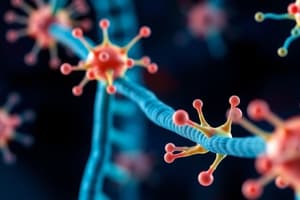Podcast
Questions and Answers
What is the role of histone modifications in gene regulation?
What is the role of histone modifications in gene regulation?
- They influence the accessibility of DNA for transcription. (correct)
- They directly synthesize RNA molecules.
- They permanently alter the DNA sequence.
- They prevent the binding of RNA polymerase.
Where are nucleosome-free regions (NFR) typically located in gene structure?
Where are nucleosome-free regions (NFR) typically located in gene structure?
- In the middle of exons.
- Randomly distributed throughout the gene.
- Only within introns.
- At the beginning and end of many genes. (correct)
How does acetylation affect gene expression?
How does acetylation affect gene expression?
- It causes DNA to be tightly packed.
- It enhances the binding of transcription factors. (correct)
- It inhibits the formation of nucleosomes.
- It increases DNA methylation levels.
What is the characteristic distribution of nucleosomes across a protein-encoding gene?
What is the characteristic distribution of nucleosomes across a protein-encoding gene?
Which chemical groups are examples of histone modifications?
Which chemical groups are examples of histone modifications?
What is the primary function of DNA methylation in eukaryotic organisms?
What is the primary function of DNA methylation in eukaryotic organisms?
In which organisms is DNA methylation most commonly observed?
In which organisms is DNA methylation most commonly observed?
What percentage of DNA is methylated in mammals?
What percentage of DNA is methylated in mammals?
What are CpG islands primarily associated with?
What are CpG islands primarily associated with?
What occurs to the expression of tissue-specific genes when their CpG islands become methylated?
What occurs to the expression of tissue-specific genes when their CpG islands become methylated?
Which component is often recruited by methyl-CpG-binding proteins?
Which component is often recruited by methyl-CpG-binding proteins?
What is most likely to happen to methylated CpG islands in housekeeping genes?
What is most likely to happen to methylated CpG islands in housekeeping genes?
Which of the following describes a characteristic of fully methylated DNA?
Which of the following describes a characteristic of fully methylated DNA?
What is the typical length of CpG islands found near the promoters of genes?
What is the typical length of CpG islands found near the promoters of genes?
Which of the following correctly describes a scenario involving the binding of an activator protein?
Which of the following correctly describes a scenario involving the binding of an activator protein?
What is the primary role of regulatory transcription factors?
What is the primary role of regulatory transcription factors?
How do enhancers affect transcription?
How do enhancers affect transcription?
What is the function of general transcription factors?
What is the function of general transcription factors?
Which of the following statements about gene regulation is true?
Which of the following statements about gene regulation is true?
What term describes the decrease in transcription resulting from the binding of a transcription factor?
What term describes the decrease in transcription resulting from the binding of a transcription factor?
In combinatorial control, which factors can influence transcription?
In combinatorial control, which factors can influence transcription?
Which of the following best describes the function of silencers?
Which of the following best describes the function of silencers?
What is a key feature of regulatory transcription factors?
What is a key feature of regulatory transcription factors?
What aspect of gene expression does timing relate to in gene regulation?
What aspect of gene expression does timing relate to in gene regulation?
Which of the following is NOT a way to modulate regulatory transcription factor functions?
Which of the following is NOT a way to modulate regulatory transcription factor functions?
What role do glucocorticoids primarily influence in cells?
What role do glucocorticoids primarily influence in cells?
Which type of chromatin conformation is difficult for transcription to occur?
Which type of chromatin conformation is difficult for transcription to occur?
What are GREs (Glucocorticoid Response Elements) primarily characterized as?
What are GREs (Glucocorticoid Response Elements) primarily characterized as?
What effect does covalent modification, such as phosphorylation, primarily have?
What effect does covalent modification, such as phosphorylation, primarily have?
What is one way chromatin remodeling complexes can change chromatin structure?
What is one way chromatin remodeling complexes can change chromatin structure?
Which enzymes are known to modify the amino terminal tails of histones?
Which enzymes are known to modify the amino terminal tails of histones?
What is the primary function of histone variants in relation to nucleosomes?
What is the primary function of histone variants in relation to nucleosomes?
What is a common consequence of the histone code on chromatin structure?
What is a common consequence of the histone code on chromatin structure?
What role do chromatin remodeling machines primarily play?
What role do chromatin remodeling machines primarily play?
How many histone genes does the human genome contain?
How many histone genes does the human genome contain?
Which of the following is a method by which ATP-dependent chromatin remodeling occurs?
Which of the following is a method by which ATP-dependent chromatin remodeling occurs?
What is the primary function of the protein called DNA translocase?
What is the primary function of the protein called DNA translocase?
Which modification on histones is primarily associated with enhancing transcription?
Which modification on histones is primarily associated with enhancing transcription?
What aspect of chromatin is dynamically altered to affect gene expression?
What aspect of chromatin is dynamically altered to affect gene expression?
Flashcards are hidden until you start studying
Study Notes
Introduction to Gene Regulation
- Gene expression is regulated to ensure accurate timing of gene expression during development and distinct cell types.
- All organisms regulate gene expression, but eukaryotes have more complex mechanisms than prokaryotes.
- The mechanisms of gene regulation enable specific genes to be expressed in specific cell types at the right time.
Regulatory Transcription Factors
- Transcription factors are proteins that influence the ability of RNA polymerase to transcribe a given gene.
- There are two main types of transcription factors: general and regulatory.
- General transcription factors are required for the binding of RNA polymerase to the core promoter and progression to the elongation stage.
- Regulatory transcription factors regulate the rate of transcription of target genes.
- Enhancers are DNA sequences that increase the rate of transcription (up-regulation) when transcription factors bind to them.
- Silencers decrease the rate of transcription (down-regulation) when transcription factors bind to them.
- Most eukaryotic genes are regulated by many factors, so the regulation is complex and involves multiple factors working together.
- Combinatorial control refers to the combined action of multiple transcription factors to regulate gene expression.
Modulation of Regulatory Transcription Factor Functions
- Transcription factors can be modulated in three common ways:
- Binding of a small effector molecule: Examples include steroid hormones.
- Protein-protein interactions: Interactions between proteins can activate or inhibit transcription factors.
- Covalent modification: Modifications such as phosphorylation can alter the activity of transcription factors.
Steroid Hormones and Regulatory Transcription Factors
- Steroid hormones influence gene expression by binding to specific receptors.
- The hormone-receptor complex acts as a transcription factor and regulates target genes.
- Glucocorticoids are steroid hormones that influence nutrient metabolism.
- Gonadocorticoids, such as estrogen and testosterone, influence the growth and function of the gonads.
- Glucocorticoid response elements (GRE) function as enhancers and are located near dozens of different genes, allowing the hormone to activate many genes.
Chromatin Remodeling and Histones
- ATP-dependent chromatin remodeling refers to dynamic changes in chromatin structure that are essential for gene expression.
- Chromatin remodeling complexes can alter the positions of nucleosomes, evict histone octamers, or change the composition of nucleosomes.
- Chromatin can exist in two conformations:
- Closed conformation is tightly packed and inaccessible to transcription factors.
- Open conformation is more accessible to transcription factors and allows for transcription.
- Histone modifications play a vital role in chromatin structure and function.
- Histone variants are incorporated into nucleosomes to create specialized chromatin.
- The histone code refers to the pattern of histone modifications that provide binding sites for proteins that regulate chromatin structure and gene expression.
DNA Methylation
- DNA methylation is a common modification in eukaryotes, where a methyl group is covalently attached to cytosine bases.
- DNA methylation usually inhibits eukaryotic gene transcription by preventing the binding of transcription factors.
- CpG islands are regions of DNA with a high concentration of CpG dinucleotides.
- Unmethylated CpG islands are typically found in housekeeping genes and genes that are essential for survival.
- Methylated CpG islands are found in tissue-specific genes, and methylation can lead to silencing of these genes.
Studying That Suits You
Use AI to generate personalized quizzes and flashcards to suit your learning preferences.




